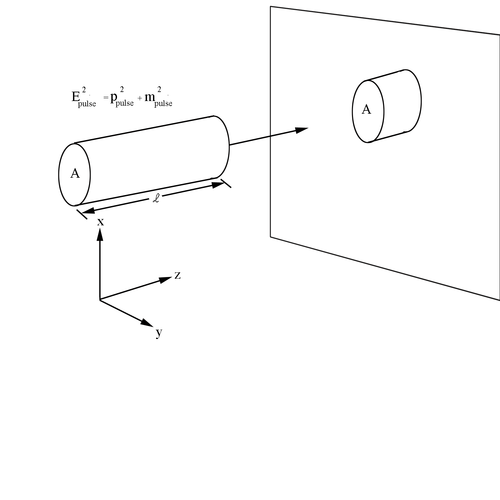|
|
| Line 42: |
Line 42: |
| | ---- | | ---- |
| | | | |
| | + | For a free particle, |
| | | | |
| | + | <center><math>E=\frac{vec_p^2}{2m}</math></center> |
| | + | |
| | + | |
| | + | Using the operator relations |
| | + | <center><math>\widehat{E}=i\hbar \frac{\partial}{\partial t} \qquad \widehat{ \vec{p}}=i\hbar \nabla</math></center> |
| | + | |
| | + | |
| | + | |
| | + | We can find the schrodinger equation for the wave function of a free particle |
| | + | |
| | + | <center><math>\Psi \equiv Ne^{i \vec_p \cdot \vec_z-iEt}</math></center> |
| | + | |
| | + | |
| | + | <center><math>i\frac{\partial \Psi}{\partial t}+\frac{1}{2m}\nabla^2\Psi=0</math></center> |
| | <center><math>E^2 \equiv p^2+m^2</math></center> | | <center><math>E^2 \equiv p^2+m^2</math></center> |
| | | | |
Revision as of 02:05, 9 July 2017
Flux of Incoming Particles
 [math]I=\frac{dq}{dt}[/math]
[math]I=\frac{dq}{dt}[/math]
Working with a beam of electrons, we can define a pulse as n charges per unit volume, each carrying charge q and moving with speed [math]v_d[/math]. Defining [math]v_d[/math] to be the time-average speed of the electrons, we can find the number of particles within a beam. If A is the beam cross-sectional area, then l, the length of the pulse , has a volume Al with nAl charges within its bounds. Since each electron carries charge q, the total charge is
[math]dq=nAlq [/math]
The time it takes the pulse to move past a given point
[math] dt=\frac{l}{v_d}[/math]
The total current is
[math]I=\frac{dQ}{dt}=\frac{nAlq}{\frac{l}{v_d}}=nAqv_d[/math]
[math]n=\frac{I}{Aqv_d}[/math]
Units of energy over volume gives
[math]\frac{J}{m^3}=\frac{N\cdot m}{m^3}=\frac{N}{m^2}=\frac{Force}{Area}[/math]
The current density
[math]j\equiv \frac{I}{A}=nqv_d[/math]
[math]n=\frac{\vec j}{q\vec v_d}[/math]
where [math]\vec v_d[/math] is the drift velocity.
Beam Power =[math]\le 5000W\ (450A\ at\ 11GeV)[/math]
For a free particle,
[math]E=\frac{vec_p^2}{2m}[/math]
Using the operator relations
[math]\widehat{E}=i\hbar \frac{\partial}{\partial t} \qquad \widehat{ \vec{p}}=i\hbar \nabla[/math]
We can find the schrodinger equation for the wave function of a free particle
[math]\Psi \equiv Ne^{i \vec_p \cdot \vec_z-iEt}[/math]
[math]i\frac{\partial \Psi}{\partial t}+\frac{1}{2m}\nabla^2\Psi=0[/math]
[math]E^2 \equiv p^2+m^2[/math]
Using the operator relations
[math]\widehat{E}=i\hbar \frac{\partial}{\partial t} \qquad \widehat{ \vec{p}}=i\hbar \nabla[/math]
[math]\widehat{E}^2 \equiv \widehat{ \vec{p}}\ ^2+m^2=(i\hbar \frac{\partial}{\partial t})^2 \equiv (i\hbar \widehat{\vec{\nabla}})^2+m^2[/math]
Working with [math]\hbar=c=1[/math]
[math]\widehat{E}^2 \equiv \widehat{ \vec{p}}\ ^2+m^2=- \frac{\partial^2}{\partial t^2} \equiv (-\widehat{\vec{\nabla}})^2+m^2[/math]
Having this equation operate on a particle's wave function, we can obtain the relativistic Schrödinger equation, also known as the Klein-Gordon equation.
[math]-\frac{\partial^2 \phi}{\partial t^2}+\nabla^2 \phi=m^2 \phi[/math]
[math]\frac{\partial}{\partial t}\left [i \left (\phi^*\frac{\partial \phi}{\partial t}-\phi \frac{\partial \phi^*}{\partial t} \right ) \right ]+\vec \nabla \cdot \left [-i\left (\phi^*\vec \nabla \phi-\phi \vec \nabla \phi^* \right ) \right ]=0[/math]
[math]\phi=Ne^{i\vec p \cdot \vec x -iEt}[/math]
[math]\rho=i(-2iE)|N|^2=2E|N|^2[/math]
[math]\vec j=-i(2i\vec p)|N|^2=2\vec p|N|^2[/math]
The number of particles in a beam passing through a unit area per unit time is
[math]\frac{Number\ of\ beam\ particles}{time\times Volume}=[/math]
[math]\frac{|\vec v_1|2E_1}{V}[/math]
The number of stationary target particles per unit volume is
[math]\frac{Number\ of\ target\ particles}{Volume}[/math]
[math]\frac{2E_2}{V}[/math]
Initial flux=[math]|\vec v_1|\frac{2E_1}{V} \frac{2E_2}{V}[/math]
[math]F=2E_1 2E_2|\vec {v}_1-\vec {v}_2|=4|E_1E_2\vec v_{21}|[/math]
where [math]v_{21}[/math] is the relative velocity between the particles in the frame where particle 1 is at rest
[math]\mathbf P_1 \cdot \mathbf P_2 = E_{1}E_{2}-(\vec p_1 \vec p_2)= E_{1}E_{2}[/math]
Using the relativistic definition of energy
[math]E^2 \equiv p^2+m^2=m^2[/math]
[math]\rightarrow \mathbf P_1 \cdot \mathbf P_2 =mE_{2}[/math]
Letting [math]E_{21}\equiv E_2[/math] be the energy of particle 2 wiith respect to particle 1, the relativistic energy equation can be rewritten such that
[math]|p_{21}^2| =E_{21}^2-m^2=\frac{(\mathbf P_1 \cdot \mathbf P_2)^2}{m^2}-m^2=\frac{(\mathbf P_1 \cdot \mathbf P_2)^2-m^4}{m^2}[/math]
where similarly [math]p_{21}[/math] is defined as the momentum of particle 2 with respect to particle 1.
The relative velocity can be expressed as
[math] v_{21}=\frac{|\vec p_{21}|}{E_{21}}[/math]
[math]F=2E_1 2E_2|\vec {v}_1-\vec {v}_2|=4|mE_{21}\vec v_{12}|=4|mE_{21}\frac{|\vec p_{21}|}{E_{21}}|=4m|\vec p_{21}|[/math]
The invariant form of F is
[math]F=4\sqrt{(\mathbf P_1 \cdot \mathbf P_2)^2-m^4}[/math]
[math]\mathbf P_1 \cdot \mathbf P_2 = E_{1}E_{2}-(\vec p_1 \vec p_2)[/math]
where in the center of mass frame [math]E_1=E_2[/math] and [math] \vec p_1^*=-\vec p_2^*[/math]
[math]\mathbf P_1 \cdot \mathbf P_2 = E_1^2+\vec p_1\,^{*2}[/math]
[math]F=4\sqrt{(E_1^2+\vec p_1\,^{*2})^2-m^4}=4\sqrt{(\vec p_1 \,^{*2}+m^2+\vec p_1\,^{*2})^2-m^4}[/math]
[math]F=4\sqrt{(2\vec p_1\,^{*2}+m^2)^2-m^4}=4\sqrt{4\vec p_1\,^{*4}+m^4+4\vec p_1\,^{*2}m-m^4}[/math]
[math]F_{cms}=4 \sqrt {4m^2\vec p_1\,^{*2}+4\vec p_1 \,^{*4}}[/math]
[math]F_{cms}=4 \sqrt {\vec p_1\,^{*2}4(m^2+\vec p_1 \,^{*2})}[/math]
As shown earlier
[math]s_{CM}=4(m^2+\vec p_1 \,^{*2})[/math]
[math]F_{cms}=4 \sqrt {\vec p_1^*\,^2s}[/math]
